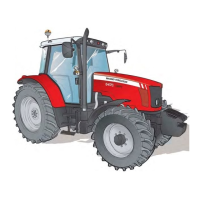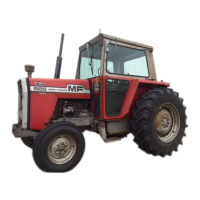Massey Ferguson 5400 - Issue 1.a
05C02.3
GBA20 Power Shuttle
A . General
The Power Shuttle, also called “ISC”, consists of two
electrohydraulically controlled clutches. It is designed
to enable operating direction reversal under load. It can
be fitted to all 5400 tractors.
The Power Shuttle transmits the drive from the engine
to the mainshaft mounted on the front of the main
gearbox by means of pinions located respectively to
the rear of the input unit and at the gearbox input.
A lever located to the left, under the steering wheel,
controls the Power Shuttle.
Depending on the position selected by the operator
(forward, neutral, reverse), the lever manages the
proportional solenoid valves of the forward and reverse
clutches by means of the electronic system of the
tractor.
The solenoid valves are located to the front and to the
right of the gearbox on a clutch unit containing the
Speedshift hydraulic control system.
A filter (60 microns) located under the selector cover,
upstream from the clutch unit, provides complemen-
tary filtering for oil supplying the solenoid valves
(clutches, Speedshift).
A progressivity sensor screwed to the box housing
sends information on shaft rotational speed to the
electronic system.
Shifting of any forward gear to the corresponding
reverse gear, or vice versa, is easy without declutching
or stopping the tractor. This “assisted” gear reversal
enables gradual changing of the operating direction,
even at high travel speeds without abrupt changes in
speed. The clutches slow down tractor movement
until the required speed is reached so that the direction
of travel can be reversed.
The conventional hydraulically operated clutch pedal is
replaced by an electrohydraulically operated manoeu-
vring pedal. This pedal modulates the pressure in the
forward or reverse clutches through the electronic
system of the tractor and thus facilitates precise move-
ments such as implement hitching.
Construction
The forward and reverse clutches of the Power Shuttle
are of different design.
Forward clutch
The forward clutch consists of:
- a conventional type oil-bath multidisc clutch
consisting of a cover (33), the rear side of which is
splined to assemble the input sun gear (53),
- an input shaft (19) crossing the spacer (4) which
separates the engine flywheel from the transmission
oil. The shaft is constantly meshed with the damper
secured to the engine flywheel. It is splined so as to
rotate with the clutch unit (18) comprising the inter-
mediate plates (30) and the discs (29) in which
piston (28) moves,
- a drive hub (27) comprising the discs (29), which is
secured to the primary shaft (55). The forward clutch
is centred in the cover (38) of the reverse clutch by
ball bearing (32).
Reverse clutch
The reverse clutch consists of:
- an epicyclic gear train consisting of three double
pinion gears (52) and three single pinion gears (59),
- a hydraulic braking device for the planet carrier (49),
- a cover (38) supporting the forward clutch and with
an inner side machined to assemble hydraulic parts.
The double and single pinion gears (52) (59) of the
epicyclic gear train mesh respectively on the input and
output sun gears (53) (58). The pins (50) are
idle-mounted and held in the planet carrier by
plates (63). A central drilled channel and radial ports
supply lubrication to the needle bearings (60).
The planet carrier braking device consists of an annular
piston (39) and a plate (43) that is loaded by springs
(62) and discs (47) integral with the planet carrier
through splines.
The intermediate plates (46) are immobilised by the
pins (71).

